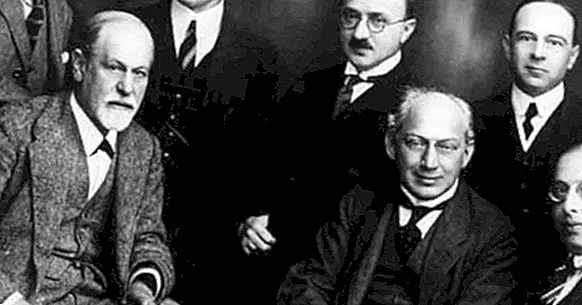6 types of psychotherapy with little or no proven efficacy
The world of psychotherapies and therapeutic approaches to psychological problems contains a wide variety of proposals. Some of them have proven to be very effective, but others exist more as a tradition or as a way of expressing a philosophy of life than as solutions that will offer guaranteed results.
That is why it is good to know both psychological therapies with more demonstrated efficacy and those whose clinical usefulness is more questioned. Next we will see the second ones: Psychotherapies with little or no proven efficacy .
Psychological therapies with little scientific validity
Keep in mind that the fact that these therapies are not well supported scientifically does not mean that they can not be pleasant or motivating experiences for some people.
This fact is what leads some patients to believe that feeling good in the sessions is indicative of the therapeutic advances that are made, but this is not the case. Psychotherapy has an objective defined by the area of intervention to which it belongs: clinical and health psychology, and therefore its effects must be noted in the way in which disorders and psychological problems in general are expressed.
That said, let's see some types of psychotherapy that they have less empirical validity than they often appear . These therapies do not appear ordered in a certain way.
1. Regression therapy
Regression therapy was born in the 19th century with the theories of the French neurologist Pierre Janet , figure that had much influence in Sigmund Freud. That is why it fits within the forms of therapy linked to psychoanalysis and the psychodynamic current in general.
Like Freudian psychoanalysis, regression therapy strongly emphasizes the importance that past experiences have in the present mental state. However, this is characterized by starting from the idea that those memories that have been stored in memory and that condition what the person is in the here and now are, in reality, false, deformations of what really happened .
The phenomenon of the spontaneous modification of memories is something that both neurosciences and cognitive sciences have been proving for some time, and yet, from the theory on which regression therapy is based, it is assumed that this deformation of memories it is due to the conflicts of the unconscious .
Currently, there is no exhaustive research or meta-analysis that demonstrates the effectiveness of regression therapy.
2. Psychoanalytic Therapy
This type of therapy has its origin in the initial ideas of Sigmund Freud, and is based on the analysis of the unconscious conflicts that originate in childhood according to the ideas of this neurologist. Psychoanalytic therapy focuses on the search for the understanding of instinctive impulses that according to Freudian theory are repressed by consciousness and stored in the subconscious affecting the patient.
The psychoanalyst therapist uses techniques such as free association, which is intended to help the patient express their cognitions (thoughts, ideas, images) and emotions without any type of repression, which would lead the patient to emotional catharsis. At present, this form of psychotherapy is used less and less in Europe, but in some countries, such as Argentina, it continues to have enormous popularity.
It is currently considered that psychoanalysis does not have solid evidence about its effectiveness , among other things for the same reasons that came to the philosopher Karl Popper to criticize this approach: if the sessions do not produce the expected effect, you can always appeal to the deceptions of the client's unconscious.
However, the social impact that psychoanalysis has had has been such that it has been claimed outside the field of health as a tool to interpret stories, artistic forms of expression and social phenomena in general. For example, it has had a great impact on radical feminism.
You can deepen this therapeutic theory in our article: "Sigmund Freud: life and work of the famous psychoanalyst"
3. Psychodynamic Therapy
Psychodynamic therapy derives from psychoanalysis, but leaves behind the classical view. It focuses on a greater therapeutic brevity and puts the focus on the most prominent conflicts of the patient's current condition. With the intention of leaving behind the classic psychoanalytic approach, it picks up aspects of the analytic approach of the self or that of the object relations of the Kleinian current.
Some psychologists such as Alfred Adler or Ackerman have participated in the development of this form of therapy, and despite the changes, the objective remains that of help the patient get "insight" about their conflicts hidden
There are a number of differences between psychodynamic and psychoanalytic therapy. Psychodynamic therapy is characterized by:
- Have shorter sessions: one or two weekly sessions. In psychoanalytic therapy there are three or four.
- An active and direct role of the therapist.
- The therapist gives advice and reinforcement not only in the conflictive aspects, but also in those that are not.
- Use a greater variety of techniques: interpretive, supportive, educational ...
As is the case with therapy based on traditional psychoanalysis, this approach neither does it have sufficient empirical evidence that indicates its clinical usefulness.
4. Humanistic therapy
Humanistic therapy emerged in the mid-twentieth century and is influenced by phenomenology and existentialism. Its main exponents are Abraham Maslow and Carl Rogers, and adopts a holistic approach to human existence and pays special attention to phenomena such as creativity, free will and human potential. It is presented as a tool that encourages self-exploration and visualization of oneself as a whole person.
While Abraham Maslow emphasizes a hierarchy of needs and motivations, Carl Rogers was the one who created the person-centered approach , more focused towards psychotherapy. In humanistic therapy the therapist takes an active role and tries to facilitate the patient (called client) becoming aware of the real experience and restructuring of their self, through the establishment of a solid therapeutic alliance.
The humanistic therapy It has been used to treat a wide range of mental health problems , including depression, anxiety, relationship problems, personality disorders and various addictions. However, there is no firm evidence about its effectiveness. However the wishful thinking and the application of "common sense" to therapy leads many people to believe that to be guided by positive vital principles and intuitively relate to the idea of happiness is to follow a really effective therapy.
- Maybe you're interested: "Maslow's Pyramid: the hierarchy of human needs"
5. Gestalt therapy
Gestalt therapy develops under the influence of humanistic philosophy, but unlike the Carl Rogers therapy, its focus is on the thoughts and feelings of the here and now, on self-awareness. The creators of this therapeutic model are Fritz Perls and Laura Perls.
Gestalt therapy is a type of holistic therapy that understands that the mind is a self-regulating unit. Gestalt therapists use experiential and experiential techniques to try to improve the self-awareness, freedom and self-direction of the patient. But nevertheless, it has nothing to do with the psychology of Gestalt , emerged before the proposals of the Perls and focused on the scientific study of perception and cognition.
Unfortunately, this approach is based more on ethical principles and abstract ideas about what is "the mind" of a happy person that in a scientifically formulated model about how mental processes and behavior work. His proposals are based on intuitive ideas about what it means to "live in the present" and gain awareness about what is happening, so it escapes any attempt to check its effectiveness in a relatively objective way.
- Related article: "Gestalt therapy: what is it and on what principles is it based?"
6. Transactional Analysis
Transactional analysis is a type of humanistic psychotherapy that, despite originating between the 50s and 60s, still applies today. It was baptized as a model of social psychiatry, in which the unit of social relation is the transaction. It is a form of therapy that is presented as a very versatile tool, and can be proposed in many contexts .
In the transactional analysis we try to work directly in the here and now, while proposing initiatives to try to help patients to develop day-to-day tools to find creative and constructive solutions to their problems. In theory, the ultimate goal is to ensure that patients regain absolute autonomy over their lives, thanks to the development of spontaneity, awareness and intimacy.
However, part of the theory on which this therapy is based uses extremely abstract or directly esoteric concepts , so it is not surprising that its scientific validity and effectiveness has proven to be very poor or practically non-existent.



















